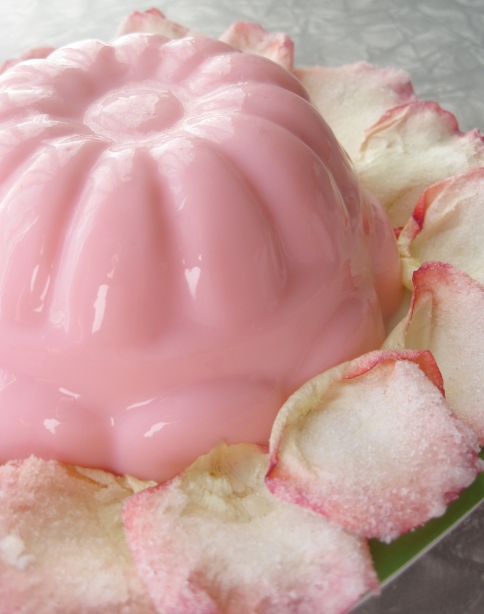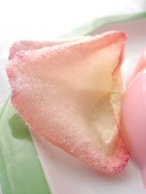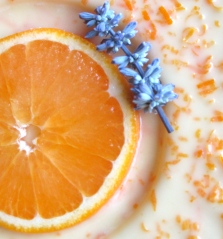You are currently browsing the category archive for the ‘Downton Abbey’ category.
To celebrate the third season of Downton Abbey, I’m re-posting a recipe from my Downton Abbey series. Oh yes, there will be more Downton inspired gelatins to come…
So yeah, like many people with Netflix and a heart, I freaking love the PBS Masterpiece Classic show Downton Abbey. I adore the rich and complicated characters, dramatic plot lines, Edwardian fashions, class struggles, women’s rights, and gelatin molds. Gelatin molds? Gelatin molds! It’s like the fine folks at Masterpiece Classic read my mind and created a television show guaranteed to suck away my time and provoke endless conversations with my girlfriends. Conversations that go like this:
Me: “So how kind and hot and sexy and smart and thoughtful is Matthew? What the hell was Mary thinking?”
Girlfriend: “I don’t care that his penis broke in the war. I’d find a way to work around it.”
Me: “I know, right?”
Or this conversation:
Me: “Did you see that creamy gelatin Daisy unmolded with Mrs. Patmore’s incessant nagging?”
Girlfriend: “No, I missed that.”
Me: “Or what about that red jelly in the first episode, what do you think that was? What would they use for food coloring?”
Girlfriend: “Uh, I don’t know.”
Me: “Didn’t you notice all those copper gelatin molds on the kitchen wall? Where can I buy those? I haven’t seen anything like that in Austin.”
Girlfriend: “I have no idea what you’re talking about.”
It’s no secret that foods made with gelatin, or “jellies” as the English say, were popular in Edwardian England. After some research (i.e. 15 minutes with goggle), I came across a myriad of Victorian and Edwardian gelatin recipes – hence my Downton Abbey Jelly Series was born. According to several cookbooks popular during Downton Abbey times, Blancmanges were common gelatin desserts that consisted of milk, sugar, citrus, and an essence of choice. See this recipe from, “The Easiest Way in Housekeeping and Cooking,” published in 1903. Since rose essence was popular in England before the commercialization of vanilla, and in honor of Mr. Molesley’s most worthy prize-winning rose, I decided to create a rose flavored blancmange.
In all honesty here, I was extraordinarily excited about this rose flavored blancmange, but was disappointed in the results. Maybe my American taste buds aren’t accustomed to rose essence, or my creamy-loving taste buds missed the fat inherent in heavy cream that is missing in just whole milk, but I found this recipe lacking in rich lusciousness. But it came out really pretty, right?
Well, this Rose Blancmange is only the first in a series of several Edwardian-era jellies to come – oh, the gelatin possibilities make me almost as excited as seeing Shirley MacLaine as Clara’s mom in season three!
Rose Blancmange Recipe for 2 cups
- One packet Knox gelatin
- ½ cup cold whole milk (for blooming gelatin)
- 1 ¼ cups whole milk (for heating)
- 2/3 cup sugar (or more to taste)
- Zest of ½ lemon
- 1 teaspoon rose water (I found rose water on the international food aisle at my local grocery store)
- 2 tablespoons brandy (optional)
- Red food-coloring (optional)
Put ½ cup of cold milk in a bowl and sprinkle gelatin on top. Set bowl aside. Over medium heat, heat 1 ¼ cups milk and sugar until sugar dissolves (be careful not to scald the milk). Add lemon zest, and remove from heat for 10-minutes. Strain mixture, and pour hot milk over the bloomed gelatin. Stir until gelatin dissolves. Add rose water, brandy, and food coloring (if using), adjusting proportions to your preference. Pour liquid into mold(s) and refrigerate until solid.
To remove gelatin, put mold into a bowl or sink full of warm water for a few seconds. After removing from water, gently shake the mold side to side. If gelatin has not separated from the edges of the mold, run a knife around the edge. Put plate on top of mold and flip over. If gelatin does not come out, try repeating the process.
Decorate with candies rose petal – I used this recipe from Food and Wine. Candied rose petals are easy, lovely, and delicious!
My unrelenting love of period melodramas continues with a second installment of my Downton Abbey Jelly Series. The first Downton Abbey post, Mr. Molesley’s Prize-Winning Rose Blancmange, was historically correct and visually lovely, but disappointing taste-wise. It turns out adapting Victorian/Edwardian recipes to modern-day ingredients and measurements is not as easy as I hoped.
For the second installment of the series, and to prevent another taste disaster, I decided to not create my own recipe but follow in the steps of my own culinary hero, Julia Child. Lucky for me, Mastering the Art of French Cooking has several recipes for the pinnacle gelatin dessert of Edwardian England – the Bavarian Cream. A Bavarian Cream (Bavarois if you’re fancy) is essentially custard with whipped cream added just before setting, a touch of gelatin to maintain shape, and a touch of flavoring and booze.
If you’ve ever made a recipe from Mastering the Art of French Cooking, you know they are not simple or straight forward. Instead they are convoluted and complicated, resulting in many tear stains on my beaten up copy. This recipe pushed my limited culinary skills to their breaking point. Needless to say, the Bavarois à l’Orange was the most work I’ve put forth for a gelatin dessert.
Let me summarize what is required for this recipe – you must separate a bunch of eggs, whip egg yolks in sugar, cook egg yolks without scrambling (I’m still shocked I pulled this off), dribble boiling milk into egg yolks, whip egg whites and fold into yolks, stir egg mixture in a bowl sitting into another bowl of ice, whip cream, and fold cream into everything else. Grating and juicing the oranges was just the easy part. Get the idea?
Complaining aside, the work put into this dessert is worth it. This is, without a doubt, the most delicate and flavorful dessert I’ve ever made. Egg yolks created a taste more rich and complicated than typical panna cottas, and addition of whipped cream and whipped egg whites created a delicate and fluffy texture that transcended – well – anything I’ve ever tasted. Since I’ve never had a Bavarian Cream before, I have no idea how “authentic” mine turned out, but I do know it was a hit at my French-themed birthday party.
A note on this recipe:
Since it would be a breach of copyright law to replicate the entire recipe on my blog (and I really hate breaking copyright laws), I will not post the recipe. However, if you’re the type of person who wants to make such a complicated and fantastically delicate dessert, you should bite the bullet and just buy Mastering the Art of French Cooking. Good news: After some research, I discovered most Bavarian Cream recipes are not nearly as complicated as Julia’s. So if you’re looking for an easier recipe, Google away!
 So yeah, like many people with Netflix and a heart, I freaking love the PBS Masterpiece Classic show Downton Abbey. I adore the rich and complicated characters, dramatic plot lines, Edwardian fashions, class struggles, women’s rights, and gelatin molds. Gelatin molds? Gelatin molds! It’s like the fine folks at Masterpiece Classic read my mind and created a television show guaranteed to suck away my time and provoke endless conversations with my girlfriends. Conversations that go like this:
So yeah, like many people with Netflix and a heart, I freaking love the PBS Masterpiece Classic show Downton Abbey. I adore the rich and complicated characters, dramatic plot lines, Edwardian fashions, class struggles, women’s rights, and gelatin molds. Gelatin molds? Gelatin molds! It’s like the fine folks at Masterpiece Classic read my mind and created a television show guaranteed to suck away my time and provoke endless conversations with my girlfriends. Conversations that go like this:
Me: “So how kind and hot and sexy and smart and thoughtful is Matthew? What the hell was Mary thinking?”
Girlfriend: “I don’t care that his penis broke in the war. I’d find a way to work around it.”
Me: “I know, right?”
Or this conversation:
Me: “Did you see that creamy gelatin Daisy unmolded with Mrs. Patmore’s incessant nagging?”
Girlfriend: “No, I missed that.”
Me: “Or what about that red jelly in the first episode, what do you think that was? What would they use for food coloring?”
Girlfriend: “Uh, I don’t know.”
Me: “Didn’t you notice all those copper gelatin molds on the kitchen wall? Where can I buy those? I haven’t seen anything like that in Austin.”
Girlfriend: “I have no idea what you’re talking about.”
It’s no secret that foods made with gelatin, or “jellies” as the English say, were popular in Edwardian England. After some research (i.e. 15 minutes with goggle), I came across a myriad of Victorian and Edwardian gelatin recipes – hence my Downton Abbey Jelly Series was born. According to several cookbooks popular during Downton Abbey times, Blancmanges were common gelatin desserts that consisted of milk, sugar, citrus, and an essence of choice. See this recipe from, “The Easiest Way in Housekeeping and Cooking,” published in 1903. Since rose essence was popular in England before the commercialization of vanilla, and in honor of Mr. Molesley’s most worthy prize-winning rose, I decided to create a rose flavored blancmange.
In all honesty here, I was extraordinarily excited about this rose flavored blancmange, but was disappointed in the results. Maybe my American taste buds aren’t accustomed to rose essence, or my creamy-loving taste buds missed the fat inherent in heavy cream that is missing in just whole milk, but I found this recipe lacking in rich lusciousness. But it came out really pretty, right?
Well, this Rose Blancmange is only the first in a series of several Edwardian-era jellies to come – oh, the gelatin possibilities make me almost as excited as seeing Shirley MacLaine as Clara’s mom in season three!
Rose Blancmange Recipe for 2 cups
- One packet Knox gelatin
- ½ cup cold whole milk (for blooming gelatin)
- 1 ¼ cups whole milk (for heating)
- 2/3 cup sugar (or more to taste)
- Zest of ½ lemon
- 1 teaspoon rose water (I found rose water on the international food aisle at my local grocery store)
- 2 tablespoons brandy (optional)
- Red food-coloring (optional)
Put ½ cup of cold milk in a bowl and sprinkle gelatin on top. Set bowl aside. Over medium heat, heat 1 ¼ cups milk and sugar until sugar dissolves (be careful not to scald the milk). Add lemon zest, and remove from heat for 10-minutes. Strain mixture, and pour hot milk over the bloomed gelatin. Stir until gelatin dissolves. Add rose water, brandy, and food coloring (if using), adjusting proportions to your preference. Pour liquid into mold(s) and refrigerate until solid.
To remove gelatin, put mold into a bowl or sink full of warm water for a few seconds. After removing from water, gently shake the mold side to side. If gelatin has not separated from the edges of the mold, run a knife around the edge. Put plate on top of mold and flip over. If gelatin does not come out, try repeating the process.
Decorate with candies rose petal – I used this recipe from Food and Wine. Candied rose petals are easy, lovely, and delicious!





